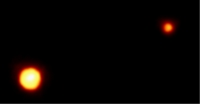
The discovery of Pluto in 1930 by Clyde Tombaugh at Lowell Observatory was the result of a long detailed search of photographic plates. The planet is too faint to be readily found by visual observation. Pluto is the smallest of the known planets; indeed it is smaller than some of the moons of the other planets. Situated about forty times the Earth's distance f rom the Sun, Pluto is a cold, dark place, with a surface temperature close to absolute zero.
Pluto is almost certainly a very light planet, made up of "rocky methane ice", with a density similar to that of water. It also has a very thin atmosphere of methane gas - this was discovered indirectly in 1988. With a diameter of only 2 302 km, Pluto is much smaller than our Moon (3 476 km). Compare these with the size of Australia, about 4 200 km across.
Pluto has a moon, Charon, which is large in relation to Pluto: 1 151 km in diameter, and about one seventh of Pluto's volume. Discovered in 1978, it orbits very close to its parent body: only 8 Pluto diameters away as opposed to the 30 Earth diameters that separate the Earth from the Moon.
Pluto is generally regarded as the outermost planet in the Solar System. However, for a period of 20 years out of every 248 years, it comes closer to the Sun than Neptune. Pluto's orbit is more oval-shaped (elliptical) than that of any other planet, while Neptune's orbit is circular. Pluto's distance from the Sun ranges from 7 400 million km down to 4 425 million km. From 1979 to 1999, Neptune will be the furthest planet from the Sun. After that, Pluto will again be the furthest for another 228 years.
Unfortunately, the Voyager probes that sent back such a lot of data from Jupiter, Saturn, Uranus and Neptune will not be visiting Pluto. It was not possible to direct the craft towards Pluto, and no probe has yet been there. The Hubble Space Telescope should add somewhat to our knowledge of Pluto and Charon, but mystery will continue to surround them until a space-probe can be sent to observe them at close range.
Physical Data
Pluto diameter: 2 302 km
Distance from Earth: 5 750 million km
Distance from Sun: 5 900 million km
Period of rotation: 6.4 days
Period of orbit: 248 years
Number of moons: 1